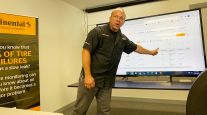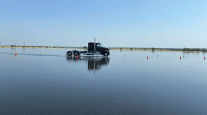E&MU: Underinflation Seen as Main Cause of ‘Road Gators’
This story appears in the November/December 2012 issue of Equipment & Maintenance Update, a supplement to the Nov. 19 print edition of Transport Topics. Click here to subscribe today.
Last summer’s record heat scorched much of the United States, with evidence of the high temperatures visible on the nation’s highways in the form of chunks of broken tires and separated treads, so-called “road gators.”
The common assumption is that this tire debris came from retreaded tires that were unable to handle the stress of high heat and highway speeds and came apart. But tire experts have long argued that retreads get an undeserved bad rap and just about universally blamed improper inflation for tire troubles that lead to “gators.”
Harvey Brodsky, managing director of the retread advocacy organization Retread Tire Association, based in Pacific Grove, Calif., emphasized that tire debris can come from a tire that never was retreaded. “Retreads are the Rodney Dangerfield of the tire business: They get no respect!” he said.
“Tires fail and come apart, throwing rubber on our highways because of improper tire maintenance, with underinflation being the main culprit, followed by overinflation, mismatching of tires in the dual-wheel position on trucks, improper tire repairs, misaligned vehicles and tires being driven with less than the legal amount of tread remaining,” Brodsky said.
“When a tire fails and comes apart on the highway because of improper tire maintenance, it does not matter whether the tire was a retread or a new tire that was never near a retread factory.” A similar argument comes from David Stevens, managing director of the Tire Retread & Repair Information Bureau, headquartered in Falls Church, Va.
“It’s a common misconception that all the rubber on the roads is from retreaded tires, but it’s simply not true,” said Stevens. “There have been state studies in Virginia and Arizona, as well as a study by NHTSA in 2008, that looked at rubber on the roads and determined it was from new and retreaded tires in equal proportion to their service on the roads.”
Stevens said that, according to those studies, the top causes of tire failures for all tires were: hitting debris already in the road, running tires underinflated and running tires overloaded. “Failures related to the original new tire manufacturing process or retreading process were almost nonexistent,” he added.
The federal study Stevens referred to was published in December 2008 by the National Highway Traffic and Safety Administration.
NHTSA’s study concluded, after examining nearly 1,500 items of tire debris collected from highways in five states to determine probable cause of failure and whether it came from original equipment or retreaded tires, that the top two reasons for tire failure were road hazards — 39% — and excessive heat — 30%.
NHTSA found that “the proportion of tire debris from retreaded tires and OE tires is similar to the estimated proportion of retread and OE tires in service.”
Furthermore, the study said that “there was no evidence to suggest that the proportion of tire fragments/shreds from retread tires was overrepresented in the debris items collected that could be assigned to a [specific tire] damage category.”
Kevin Rohlwing, senior vice president of training for the Tire Industry Association in Bowie, Md., added to the argument, saying that “[American Trucking Associations’] Technology & Maintenance Council studies have shown that new tires and retreads fail at the same rate, and 90% of them are caused by underinflation and/or overloading.”
William De Andrade had more than 16 years’ experience as a retreader with major retread company Bandag Inc. before becoming the operations manager, partner and member of the board for AMV Dominica, a provider of tire-related services to fleet customers in the Dominican Republic. He also blamed improper inflation.
“Those ‘gators’ on the road are nothing but a portion of the belt package that was separated from the tire, and . . . the No. 1 reason for a belt package separation is improper air pressure,” De Andrade said.
He said tire debris on the highway is really a reflection of better tires in recent decades. “The constant improvement by new tire manufacturers in the performance of their products is the real reason you may encounter ‘gators’ on the road,” De Andrade said.
“Back when most tires were bias [ply], a truck tire with more than 50,000 miles was considered a ‘top of the line’ product,” De Andrade said.
“New tire manufacturers are now targeting — and achieving — a 1 million-mile mark on casings, including original life and retreads. Tires lasting that long require only one thing: proper maintenance,” he said.
Summer is associated with more tire debris, but the reasons are complex. There are generally more passenger vehicles on the highways for summer vacation travel, which could contribute to more anecdotal reports of debris. TRIB’s Stevens said his organization had not seen any data of increased failure rates this past summer.
“Heat is the enemy of all tires, both new and retreaded,” Stevens said. “You normally see more tire failures for all tires during the summer months due to increased heat. Once you add high surface temperatures to existing heat buildup in tires that are being run underinflated or overloaded, you create an environment that stresses the tire and can eventually lead to failure.”
TIA’s Rohlwing also emphasized that heat plays the most important role when it comes to tire failures.
“When new tires or retreads have the correct inflation pressure for the load, they can withstand record temperatures without a problem. But an underinflated or overloaded tire experiences excessive flexing, which creates additional heat,” he said. “It’s natural to see more tire debris in the summer months because the higher ambient temperatures make a bad problem worse.”
Heat also is associated with increased tire deterioration for other reasons. The NHTSA study explained that increased heat decreases rubber tear resistance, which promotes crack initiation and propagation, and because rubber becomes more brittle, it cannot as successfully counter the overflexing that accompanies underinflation.
One tell-tale sign of tires operating at ex-cessive temperatures is a bluish discoloration of the rubber, especially visible in either in the tread or shoulder areas, the NHTSA study said.
Experts, including TIA’s Rohlwing and Guy Walenga, director of engineering, commercial products and technologies for Bridgestone Americas Inc. tire operations in Nashville, Tenn., agreed that ambient temperatures exceeding 100 degrees Fahrenheit have little effect on tire performance because tires are designed to operate safely with internal temperatures that are generally 60 degrees higher than ambient resting temperature, created by heat from anticipated sidewall flexing in normal operation. Bridgestone owns major retreader Bandag.
What may not be considered is a driver’s expectation that sweltering outside temperatures will expand air in tires enough to compensate for any underinflation. That is a mistaken assumption, Rohlwing said.
“Any gains in pressure from air expansion due to heat are so small that they will quickly be overcome by the extreme heat caused by excessive flexing,” said Rohlwing. “As the tire absorbs that heat, the stress starts to break down the bonds between the belts. Eventually, the abuse takes its toll and you get a separation.”
Rohlwing added, “An underinflated tire may take weeks to fail in the winter, but the same tire may take only days in the summer because the average temperature of the tire will be so much higher.”
TRIB’s Stevens said that one of the few instances in which tires can overinflate comes from heat generated by dragging brakes or long use of brakes going down hills. “This type of exposure can cause very high overinflation due to the extreme heat generated and transferred to the wheel and tire,” Stevens said.
“This type of heat will also cause beads to turn brittle and fail, usually on the inside tire on dual-wheel applications,” Stevens added.
Most tire failures occur in trailer positions, the NHTSA study found, and a tire manufacturer study revealed that most shredding results from drivers continuing to drive on a tire after air loss.
If a driver limps home on a dual where one tire has disintegrated, the remaining good tire will be overloaded, Walenga cautioned. “The second tire will fatigue quickly and fail shortly thereafter,” he said, “so both tires at that position usually need to be replaced.”
Retreads are widely used in trucking, Stevens said.
“It has gone back and forth over the years, but the split between replacement and retreaded tires in the commercial truck segment has often hovered around a 50/50 split,” he said.
In 2011, there were approximately 4.7 million original equipment commercial truck tires shipped, 17.3 million replacement truck tires shipped, and 15.3 million retreaded truck tires produced, Stevens said.
Jack Bernard, supervisor of tire management at USA Truck Inc., is an advocate for retreads, based on his extensive cost-per-mile calculations.
“Across the fleet, about 70% of my tires are retreads,” he said recently.
Bernard said he has seen no difference in failure rates for his fleet’s tires based on either the season of year or whether they were new or retreaded.
USA Truck is a dry-van truckload and dedicated contract carrier based in Van Buren, Ark., that ranks No. 49 on the Transport Topics Top 100 For-Hire Carriers in the United States and Canada. The company operates about 2,300 tractors and 6,300 trailers.
NHTSA’s researchers in the 2008 tire-debris study stated that they could not find any systematic manufacturing or process issues with either original manufacturer or retreaded medium truck tires.
Retreads’ bad reputation is outdated, according to the experts consulted for this story. Modern truck tires are designed to be retreaded two or three times,
and technology and quality assurance in producing retreads has improved markedly in the past 30 years, they said.
Inspection ensures that casings are suitable for retreading, with testing that includes laser shearography to detect minute bulges that indicate component separation and non-destructive testing that uses high-voltage electric current to locate holes or hidden nails.
“It’s another myth about retreaded tires that the new tread is simply ‘glued-on’ to the old tire and that’s why you see treads on the road,” said TRIB’s Stevens. “In fact, during the vulcanization process, the rubber in the tire goes through a chemical change that bonds the tire together in much the same way a new tire is manufactured.”




